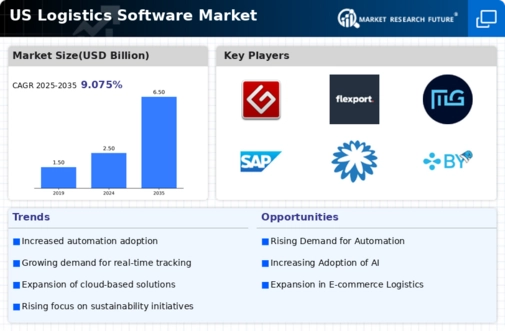The US Logistics Software Market is characterized by a dynamic landscape where competition is intense among various players, offering a suite of solutions aimed at optimizing supply chain operations. This market has seen a significant evolution due to the increasing need for efficiency, transparency, and real-time data in logistics.
Companies are focusing on technological advancements such as cloud computing, artificial intelligence, and machine learning to enhance their offerings. Competitive insights reveal that the market is driven by the demand for seamless integration of logistics processes and the need for analytical tools that provide businesses with the ability to make data-driven decisions.
These factors contribute to the development of innovative logistics management software designed to meet the diverse needs of different industries, further intensifying competition in the sector.
Project44 stands out in the US Logistics Software Market with its comprehensive visibility platform that addresses the complexities of modern supply chains. The company's strength lies in its ability to provide real-time insights into freight operations, which allows businesses to make informed decisions quickly.
By focusing on enhancing supply chain visibility, Project44 enables companies to improve their operational efficiency and customer service. The platform integrates with various Transportation Management Systems (TMS), offering seamless connectivity that enhances the overall logistics process.
Project44's strong market presence is further underlined by its continual investment in technology and partnerships, positioning it as a key player committed to enhancing supply chain performance across various sectors. Its proactive approach to addressing customer pain points has bolstered its reputation within the industry, establishing a competitive edge in the US market.
Flexport has established itself as a leading logistics technology platform in the US, focusing on offering a full suite of services that streamline freight forwarding and logistics management. The company’s key products include international freight forwarding, customs brokerage, and real-time tracking solutions that aim to simplify the complexities of global shipping.
Flexport's strengths lie in its ability to provide a user-friendly interface combined with extensive data analytics capabilities, which help shippers optimize their logistics operations efficiently. The company has made significant strides in improving its market presence through strategic partnerships and acquisitions, which enhance its service offerings and expand its reach within the US market.
Flexport's commitment to innovation, reflected in its continuous introduction of cutting-edge technology and logistics solutions, positions it favorably among competitors, making it a formidable force in the domestic logistics landscape. Moreover, its focus on providing tailored solutions allows Flexport to cater to a diverse clientele, further solidifying its position in the market.
























